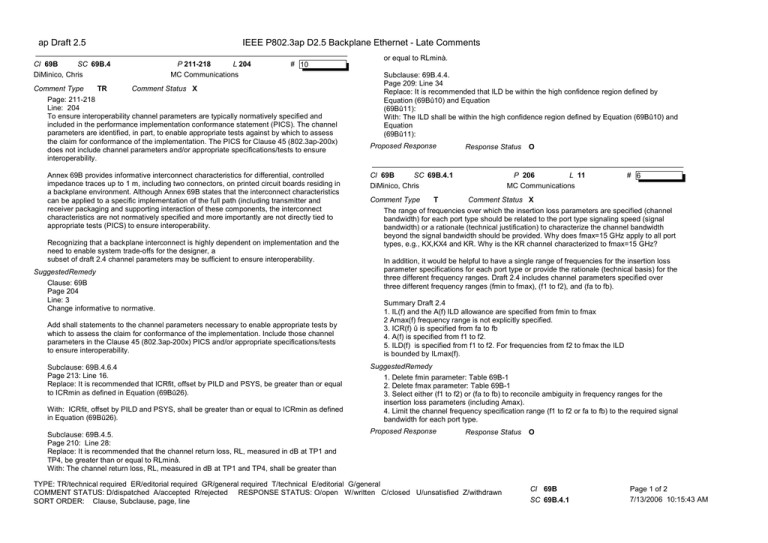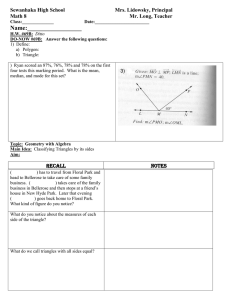IEEE P802.3ap D2.5 Backplane Ethernet
advertisement

ap Draft 2.5 Cl 69B SC 69B.4 DiMinico, Chris IEEE P802.3ap D2.5 Backplane Ethernet - Late Comments P 211-218 L 204 MC Communications # 10 Comment Status X Comment Type TR Page: 211-218 Line: 204 To ensure interoperability channel parameters are typically normatively specified and included in the performance implementation conformance statement (PICS). The channel parameters are identified, in part, to enable appropriate tests against by which to assess the claim for conformance of the implementation. The PICS for Clause 45 (802.3ap-200x) does not include channel parameters and/or appropriate specifications/tests to ensure interoperability. Annex 69B provides informative interconnect characteristics for differential, controlled impedance traces up to 1 m, including two connectors, on printed circuit boards residing in a backplane environment. Although Annex 69B states that the interconnect characteristics can be applied to a specific implementation of the full path (including transmitter and receiver packaging and supporting interaction of these components, the interconnect characteristics are not normatively specified and more importantly are not directly tied to appropriate tests (PICS) to ensure interoperability. Recognizing that a backplane interconnect is highly dependent on implementation and the need to enable system trade-offs for the designer, a subset of draft 2.4 channel parameters may be sufficient to ensure interoperability. SuggestedRemedy Clause: 69B Page 204 Line: 3 Change informative to normative. Add shall statements to the channel parameters necessary to enable appropriate tests by which to assess the claim for conformance of the implementation. Include those channel parameters in the Clause 45 (802.3ap-200x) PICS and/or appropriate specifications/tests to ensure interoperability. Subclause: 69B.4.6.4 Page 213: Line 16. Replace: It is recommended that ICRfit, offset by PILD and PSYS, be greater than or equal to ICRmin as defined in Equation (69Bû26). With: ICRfit, offset by PILD and PSYS, shall be greater than or equal to ICRmin as defined in Equation (69Bû26). Subclause: 69B.4.5. Page 210: Line 28: Replace: It is recommended that the channel return loss, RL, measured in dB at TP1 and TP4, be greater than or equal to RLminà. With: The channel return loss, RL, measured in dB at TP1 and TP4, shall be greater than or equal to RLminà. Subclause: 69B.4.4. Page 209: Line 34 Replace: It is recommended that ILD be within the high confidence region defined by Equation (69Bû10) and Equation (69Bû11): With: The ILD shall be within the high confidence region defined by Equation (69Bû10) and Equation (69Bû11): Proposed Response Response Status Cl 69B SC 69B.4.1 DiMinico, Chris O P 206 L 11 MC Communications # 6 Comment Status X Comment Type T The range of frequencies over which the insertion loss parameters are specified (channel bandwidth) for each port type should be related to the port type signaling speed (signal bandwidth) or a rationale (technical justification) to characterize the channel bandwidth beyond the signal bandwidth should be provided. Why does fmax=15 GHz apply to all port types, e.g., KX,KX4 and KR. Why is the KR channel characterized to fmax=15 GHz? In addition, it would be helpful to have a single range of frequencies for the insertion loss parameter specifications for each port type or provide the rationale (technical basis) for the three different frequency ranges. Draft 2.4 includes channel parameters specified over three different frequency ranges (fmin to fmax), (f1 to f2), and (fa to fb). Summary Draft 2.4 1. IL(f) and the A(f) ILD allowance are specified from fmin to fmax 2 Amax(f) frequency range is not explicitly specified. 3. ICR(f) û is specified from fa to fb 4. A(f) is specified from f1 to f2. 5. ILD(f) is specified from f1 to f2. For frequencies from f2 to fmax the ILD is bounded by ILmax(f). SuggestedRemedy 1. Delete fmin parameter: Table 69B-1 2. Delete fmax parameter: Table 69B-1 3. Select either (f1 to f2) or (fa to fb) to reconcile ambiguity in frequency ranges for the insertion loss parameters (including Amax). 4. Limit the channel frequency specification range (f1 to f2 or fa to fb) to the required signal bandwidth for each port type. Proposed Response Response Status TYPE: TR/technical required ER/editorial required GR/general required T/technical E/editorial G/general COMMENT STATUS: D/dispatched A/accepted R/rejected RESPONSE STATUS: O/open W/written C/closed U/unsatisfied Z/withdrawn SORT ORDER: Clause, Subclause, page, line O Cl 69B SC 69B.4.1 Page 1 of 2 7/13/2006 10:15:43 AM ap Draft 2.5 Cl 69B SC 69B.4.3 DiMinico, Chris IEEE P802.3ap D2.5 Backplane Ethernet - Late Comments P 208 L 3-50 MC Communications # 8 SuggestedRemedy Either remove text "high confidence region" or remove Amax in Figure 69B-2, 69B-3, and 69B-4 Cl 69B SC 69B.4.3 DiMinico, Chris Response Status O P 208-209 L 3-50 MC Communications P 212 L MC Communications # 9 Comment Status X Comment Type T 1. In equation (69B-24) the PILD calculation results in a -0.8 penalty when ILD=0 and A(fb) = Amax(fb)? Comment Status X Comment Type T Page: 208-209 Line: 3-50 and 2-24 Please clarify high confidence region. Is it bounded by ILmax or Amax? IÆm assuming ILmax. Proposed Response Cl 69B SC 69B.4.6.4 DiMinico, Chris # 7 Comment Status X Comment Type T Page: 208-209 Line: 3-50 and 2-24 The range of frequencies over which the insertion loss parameters are specified (channel bandwidth) for each port type should be related to the port type signaling speed (signal bandwidth) or the rationale (technical justification) to characterize the channel bandwidth beyond the signal bandwidth should be explicitly provided. 2. The IL deviations in 802.3ap is defined as the difference between the IL(f) and the least mean squares fit A(f). ILD(f) exhibits an oscillatory behavior over frequency. The PILD results in a level offset penalty and may not appropriately account for the oscillatory ILD channel self-interference. 3. The source of the channel self-interference impairments generally associated with the oscillatory behavior is the re-reflected propagating waves (forward echo) often considered directly as a noise penalty. SuggestedRemedy Consider ILD as defined in 802.3ap directly as a noise penalty and include explicitly as a requirement for the test channel specified in 69A.2.2 test channel. Proposed Response Response Status O SuggestedRemedy Limit the channel frequency specification (channel bandwidth) ranges plotted in Figure 69B2, 69B-3, and 69B-4 to the required signal bandwidth for each port type (f1 to f2 or fa to fb). Proposed Response Response Status O TYPE: TR/technical required ER/editorial required GR/general required T/technical E/editorial G/general COMMENT STATUS: D/dispatched A/accepted R/rejected RESPONSE STATUS: O/open W/written C/closed U/unsatisfied Z/withdrawn SORT ORDER: Clause, Subclause, page, line Cl 69B SC 69B.4.6.4 Page 2 of 2 7/13/2006 10:15:43 AM

